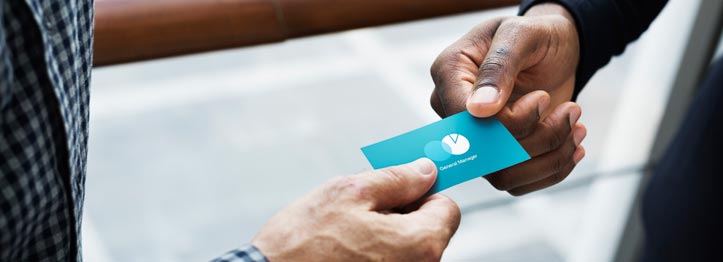In the digital age of social media, sales funnels, and PPC advertising, it’s easy to lose sight of some of the networking basics that have worked for decades. And as a Houston landlord or real estate investor, you shouldn’t quickly forget the power of a physical business card. With the right approach, a business card can become one of your top networking tools and influential points of engagement.
This is the first question most people ask when a discussion about business cards comes up. It’s especially common among younger professionals in the industry. And while it’s certainly necessary to have a strong digital presence, we need to embrace the fact that business cards still hold weight and influence. Just ask entrepreneur Madison Carr.
“In most of my encounters, once I tell someone I run a business, they usually ask for a business card. This is an incredible opportunity to direct them to my website,” Carr explains. “My website, like most businesses, is the prime place I want to get potential clients. The proof of my skill is in my portfolio, and I want them to get to it as easily as possible. A business card is a much easier way of giving them my website then verbally telling them and hoping they remember correctly!”
Business cards are inexpensive (usually costing pennies per card) and easy to hand out and leave around. (You can leave a card with your tip at a restaurant, tack it to a bulletin board, or hand it to someone you meet.) They’re appropriate in almost any setting and have virtually no downsides or risks attached to them.
The problem with business cards is that most real estate professionals squander the opportunity to make a strong impression by designing ineffective and/or forgettable cards.
If you want your business card to work for you, it needs to be carefully optimized and strategically designed. Here are a few helpful recommendations:
The smiling headshot is one of the classic elements of a real estate business card. (After all, you’re in the people business. Why not show yourself off?) But perhaps you should think twice before putting your mug on your business card.
A few years back, attorney Eric Bryn decided to run an experiment. He found it odd that real estate professionals plastered their business cards with their photos (something professionals in other industries do not do). So he ran a test, printing 2,000 business cards for a client. The business cards both had the exact same message and design, with one exception. One card featured the picture of the agent and the other did not. And the results were pretty astounding.
Bryn and his team got zero responses from the 1,000 cards that contained the agent’s photo, while receiving 200 responses from the cards without the photo.
If you think this is an anomaly, Bryn is quick to point out that he’s run multiple tests like this on other types of agent marketing and finds that no photo always outperforms the one with the photo.
Many agents swear by their photo, but few have ever run an experiment like this. Perhaps we should trust the data, however unofficial it may be.
Most business cards are fairly flimsy. They’re thicker than paper, but are still pretty flexible. A 12pt or 14pt cardstock is pretty common.
One easy way to set yourself apart is to go with thicker cardstock. Something like 19pt, or even 32pt cardstock, can give your business card a heavier and more substantial feel.
In addition to holding up longer over time, thick business cards make a statement. People immediately feel the difference and know that you spent money on your business card. This elevates you as someone who is successful and committed.
Colors matter. For maximum visual impact, use contrast. A black background with bright and bold colors in the foreground can really help you stand out. There’s also something to be said for a white background with simple black lettering in the foreground. Either way, the use of contrast engages the eyes and makes the card more visually stimulating and memorable.
“There are many trendy colors and typefaces that you can use on your card to make it stand out — and there’s nothing wrong with that, as long as your card doesn’t look like a circus ad,” Zillow advises. “Don’t cover every millimeter of the card with text or graphics, or you run the risk of overwhelming contacts, who won’t know what to retain.”
Simple sells. Strip out all of the unnecessary fluff (including superfluous contact details) and focus on the elements that truly matter. This makes your business card less intimidating and more practical.
It’s easy to see all of the individual elements of your business card when viewing it on a computer or graphic design tool. But when the card is printed, you have to remember that it’s much smaller. In light of this, account for font size and legibility when designing. People shouldn’t have to squint to read your email address or phone number.
People expect consistency. If you give them one image and then show them something different, they’ll feel duped or confused. Provide a consistent experience by using the same colors and logos on your business card, website, and social media profiles.
At Green Residential, we understand the importance of networking. We know that every Houston real estate professional is just one or two good connections away from striking a deal. And while we can’t help you design a business card, we can do just about everything else for your business.
From marketing your properties and screening tenants to collecting rent and scheduling repairs, our Houston property management services exist to make your life easier. Contact us today to get a free property analysis!
